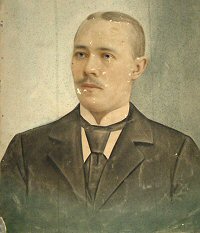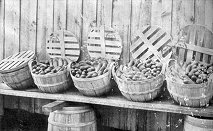Down in Alabama
By Eric T. Winberg

Dr. Winberg's full name was Oscar Fridolf Eskil Winberg,
but in Silverhill he was known as Dr. O.F.E. Winberg.

Down in the Deep South, where the State of Alabama narrows down to a wedge between Florida and Mississippi, lies Baldwin County, which proudly proclaims itself to be the richest farm county in the United States. Large signs along the road (in 1939) tell the traveler that Baldwin County had a higher income per acre than any other agricultural county in the whole nation in 1936. Be that as it may, Baldwin County is nevertheless in many respects unusual for the South. It is not that the climate is subtropical or that there is a rainfall pretty close to sixty inches a year down by the Gulf of Mexico, but the neat little houses, mostly painted white with red cornices, and the well-kept gardens in which, as often as not, one will find blonde children cavorting around, do not give the picture one usually associates with the South. And then the crops grown in this county are very different from most of those raised in the South.
In the year 1896 the southern half of Baldwin County had only a small number of native American settlers, and no roads of any description. That year a Swedish engineer, working for a steel concern in Chicago, had occasion to travel through Alabama and, while in the town of Mobile, he went on a fishing trip which took him to the east side of Mobile Bay. He went ashore there and saw only pine trees stretching for miles in every direction, but he also noticed that the soil was unusually fertile and he liked the climate. The name of this traveler was Oscar Johnson. He noted the possibilities of developing this section of Alabama into rich farmlands and he undertook to induce some of his fellow immigrants to America to go down there and become pioneers.
On his return to Chicago he formed the Svea Land Colony, which the same year bought up 30,000 acres of woodland in southern Baldwin County. This area was divided into parcels of about 40 acres each. By promotion and advertising in the Swedish-language press in America the company succeeded so well in disposing of this land that in the Spring of 1897 the first settlers of Swedish stock arrived. They faced a hard job and in most cases they lacked both money and the essentials for developing farmland out of the pine woods. Only a few of them had any knowledge of farming and would not have been able to do much at that stage even if they had known what to do.
In order to survive the first hard years, it was necessary for them to take temporary jobs in the town of Mobile, across the bay, or odd jobs up farther north. Little by little they succeeded in wresting the land from the pine trees, and by 1904 so many settlers had arrived that a railroad company considered the time ripe for extending its line down through the south of the county.
In selecting a name for the new settlement, Oscar Johnson and his associates decided upon the name of Silverhill, because it was already recognized before the settlers from the North arrived.
It is said that the man operating a turpentine plantation a mile east of where the Silverhill community is now located, always paid his employees in silver coin, so they came to call him Silver, and the hill where his turpentine still was located, they called Silverhill. According to tradition the territory now known as Silverhill was known by that name as early as 1859.
 In the Spring of 1905 a young Swede by the name of Oscar Winberg, living in Chicago, was told about the settlement in Alabama and about its wonderfully mild climate and fertile soil. He decided to investigate. Consequently he took a trip down there, and, finding things to his liking, he bought 160 acres of land. As his first task he took a compass and an ax and went out and blazed a trail from Silverhill to another settlemant. This became the first road laid out in the south of Baldwin County.
In the Spring of 1905 a young Swede by the name of Oscar Winberg, living in Chicago, was told about the settlement in Alabama and about its wonderfully mild climate and fertile soil. He decided to investigate. Consequently he took a trip down there, and, finding things to his liking, he bought 160 acres of land. As his first task he took a compass and an ax and went out and blazed a trail from Silverhill to another settlemant. This became the first road laid out in the south of Baldwin County.
After the construction of the railroad the settlers rapidly increased their tillable acreage. The first highway soon was followed by others, and the horse and buggy instead of horseback became the chief means of transportation among the villages of Fairhope, Silverhill, Foley, Robertsdale, and Loxley.

During the winter of 1905-06, Dr. Oscar Winberg institued a series of lectures on modern farming methods and suggested the crops most likely to be successful in the region. A representative from a produce firm in Chicago arrived and offered the
farmers contracts for all the cucumbers and potatoes they could grow. He also offered to supply seeds and fertilizers. The settlers consulted with Dr. Winberg, who definitely advised against the contracts. Nevertheless these were accepted and signed. The Autumn of 1906 was a bitter experience for the small communities, because most of the farmers found themselves in debt to the firm in Chicago. However, the experience did not prevent their signing new sets of contracts for the following season with its two crops, and the result was equally disastrous. The next year at the suggestion of Dr. Winberg, who had become the community adviser, the settlers formed a cooperative society. From then on the income from the truck farming rose to as high as one thousand dollars per acre, from the two crops the soil and the climate were able to give a year.
If someone had a toothache or malaria, or if a family was undecided as to what future to choose for a son, or if the crops failed or it didn't rain, Dr. Winberg was called and consulted. While on a ride on such an errand, he once happened upon a very unusual sight, an orange grove.
"It was beautiful," he told this writer, "not only from an aesthetic point of view but also from the standpoint of commercial possibilities. This struck me at once and I carefully examined the trees and found them to be of a rather strange kind for America. It was a Chinese orange known as the Satsuma. I immediately started gathering all the informaton I could on this type of fruit. I corresponded with several growers in China and Japan and got all the literature and information I could from sources in the United States. I found out how these trees grow under various conditions of altitude, rainfall, temperature, and type of soil. The Satsuma is a typical subtropical fruit, which will not thrive in the latitudes of Florida or Cuba, but is very suitable for the type of climate we have in Baldwin County."
Dr. Winberg discovered the Satsuma in Alabama in 1906 and kept on experimenting with it the following years. In 1910 he was invited to attend a meeting of the American Chemical Society and stopped off in Chicago, where he informed the press about his new orange grown in America. He also persuaded the settlers of Swedish stock in Alabama to
raise this orange. By 1914 the cultivation of the Satsuma had progressed so far that another cooperative society was formed in Silverhill, which now (in 1939) sells this orange for growers in Florida, Alabama, and Mississippi to the tune of $1,500,000 a year.

In 1914 Dr. Winberg also organized the Horticultural Society of Alabama. He was a member of the State Board of Horticulture of the State of Alabama, from 1915 to 1924. He has delivered addresses at universities, and has written a large number of articles on horticulture. Dr. Winberg, who is a native of Västergötland, Sweden, is now a recognized world authority on the cultivation of oranges and has at the present sixty varieties under cultivation on his land at Silverhill, which has grown considerably in acreage from the first 160 acres. His experimental orange groves are considered the largest in the world, and he receives many distinguished visitors from such far-off places as South Africa, Sweden, and Japan. A regular visitor every fourth or fifth year is Dr. Tanaka, head of the Imperial Horticultural Society of Japan, who stays a month at a time. Among the varieties grown and cultivated in the experimental groves at Silverhill are Shintani, Silverhill, Ishikawa, and Hosaki. The latter variety threatens to displace the Satsumas as the best orange tree in the regions of Alaska which were settled by people of Swedish stock.
On the mailboxes outside the well-kept houses one sees such names as Swedelius, Rundquist, Lundgren, Andersson, and Johnson. Dr. Winberg assured me that there is not one individual of Scandinavian background in Baldwin County who is not well off today.
Incidentally, the horticulture of Sweden stands high in the esteem of experts. Dr. Tanaka, of Tokyo, informed Dr. Winberg on one of his stays in Silverhill that a statue has been erected in Tokyo to the Swedish botanist Thunberg, and that the textbooks of another eminent Swede, Bengt Lidfors, are used in the Japanese Schools.
Dr. Hail, an old and distinguished southern doctor, who had practised medicine for four years when, in 1898, malaria forced him from the Mississippi Delta to Baldwin County, was also interviewed by this writer, who incidentally was the first Swedish journalist to visit the settlements.
"The Swedes," said Dr. Hail, with typical Southern chivalry, "are the best people ever to come to Alabama. I wish more of them would come and say 'Alabama' in the true meaning of the word: "Here we rest."

Source: 1939 Archives of The American Swedish Institute; a copy of the paper in the possession of Ted Forsman.

The Growing of Satsuma Oranges in Alabama
O. E. F. Winberg, Silverhill, Alabama
A Lecture Given at the Florida State Horticultural Society, 1920
A PDF File 

THE SILVERHILL: A PROMISING AND APPARENTLY HARDY STRAIN OF SATSUMA ORANGE
Walter T. Swingle
1931 Vol. 44 pages 201-202
A PDF File 

|